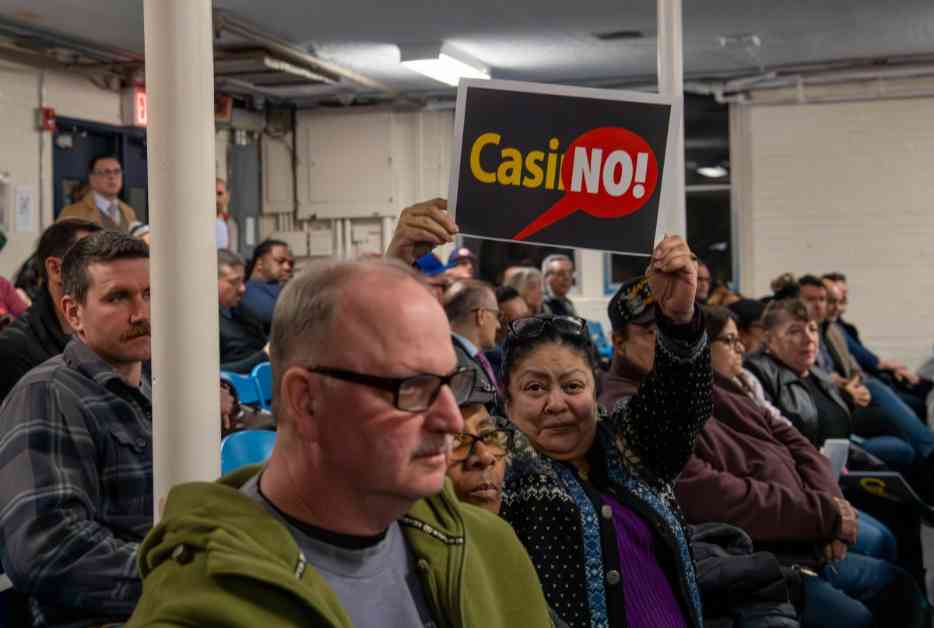More than 100 Bronx residents gathered at a local high school for a significant event – Community Board 10’s public hearing regarding Bally’s proposed casino project in Throggs Neck. The casino, set to be constructed in Ferry Point Park, has stirred up significant controversy among the attendees, many of whom are staunchly against the development.
Residents from the Throggs Neck area voiced their concerns about potential issues such as crime, public safety, traffic congestion, and the loss of parkland that would accompany the casino’s arrival. The project, spearheaded by Bally’s, aims to create a 3.1 million-square-foot complex at the existing city-owned golf course on the site – a golf course previously managed by a company with ties to former President Donald Trump.
Christopher Jewett, the Senior Vice President for Corporate Development at Bally’s, kicked off the hearing with a detailed presentation outlining the scope of the project, the amenities it would offer, and the benefits it could bring to the local community. The proposed casino would include a 500,000-square-foot gaming hall, a 500-room hotel complete with a spa and meeting space, retail shops, a 2,000-seat event center, and two parking garages capable of accommodating up to 4,660 vehicles. Spread across 19 acres of the public golf course, the development promises to make a significant impact on the area.
During the hearing, Jewett highlighted the positive aspects of the project, including the creation of 4,000 permanent union jobs, improvements to parkland, and the establishment of a privately funded police station. Despite Jewett’s claims that over 80% of attendees supported the project, skepticism was evident among the residents present. Some individuals even disrupted the proceedings, expressing their doubt through vocal outbursts and signs bearing messages like “CasiNO!” and “No Transparency!”
One of the major concerns raised by residents during the hearing was the potential correlation between the casino and increased crime rates in the neighborhood. Many attendees cited examples from other cities, such as Atlantic City, where the introduction of casinos allegedly led to spikes in criminal activities like burglaries, prostitution, and drug use. Deborah Teska, a long-time Throggs Neck resident, shared her apprehensions based on personal experiences in areas surrounding casinos in Atlantic City.
In response to these fears, Bally’s has assured the community that it is taking crime prevention seriously. The company has committed to funding a new NYPD station, either within the casino complex or in close proximity, and plans to employ private security throughout the development. Despite these reassurances, many residents remain unconvinced, expressing concerns about the impact the casino could have on the safety of the surrounding neighborhoods.
Another significant issue that arose during the hearing was the potential use of public park space for the casino project. The proposal includes the alienation of 19 acres of parkland, currently part of the public golf course operated by Bally’s, for the development. While the company has pledged to rebuild golf course amenities in a different section of the park and add new parkland to replace the alienated space, residents are apprehensive about losing valuable green areas in the neighborhood.
Furthermore, traffic concerns were at the forefront of many residents’ minds. Bally’s has proposed several infrastructure improvements to address potential traffic congestion, including widening roads, upgrading storm drainage systems, and constructing an overpass on Lafayette Avenue. However, some attendees expressed doubts about the effectiveness of these measures, particularly in light of existing traffic challenges in the Bronx.
Despite the division among residents, some supporters of the casino project believe that it could bring economic benefits to Throggs Neck through job creation. However, the majority of those who spoke at the hearing expressed opposition to the proposal. Bronx elected officials have yet to take a definitive stance on the project, with concerns ranging from traffic issues to the social impact of gambling addiction.
The Bally’s Bronx proposal is just one of several casino projects vying for limited gambling licenses in downstate New York. As the debate continues, the fate of the Throggs Neck community hangs in the balance, with residents and officials alike weighing the potential benefits and drawbacks of the proposed casino development.

